Batman: The Killing Joke (R) ★★½
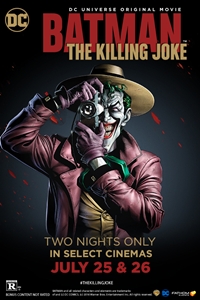 Those whose only exposure to the Marvel and DC superheroes has come through the various live-action films that have been made over the last 40+ years may be unaware that a second, entirely separate series of animated productions have thrived (mostly as direct-to-video fare) during the same time period. Some "purist" fans have identified more strongly with these movies because many represent quasi-faithful remakes of actual comic books (or graphic novels) and some of the so-called "compromises" made by the live-action pictures have been avoided.
Those whose only exposure to the Marvel and DC superheroes has come through the various live-action films that have been made over the last 40+ years may be unaware that a second, entirely separate series of animated productions have thrived (mostly as direct-to-video fare) during the same time period. Some "purist" fans have identified more strongly with these movies because many represent quasi-faithful remakes of actual comic books (or graphic novels) and some of the so-called "compromises" made by the live-action pictures have been avoided.
Batman made his animated motion picture debut in 1993's well-received Mask of the Phantasm. The movie, which headed straight-to-VHS after a short theatrical run, introduced Kevin Conroy as Batman and Mark Hamill as The Joker. Twenty-three years later, those two would still be providing voices for the same characters when Warner Animation/DC decided to bring one of the most requested graphic novel stories, the Alan Moore/Brian Bolland collaboration, The Killing Joke, to the animated medium. Hamill, who had previously indicated a desire to retire his voice, elected to return and, at least to date, this is the last movie in which he and Conroy have crossed paths.
Most of the justified criticism leveled against the film relates to the odd and disjointed structure of the screenplay. Recognizing that a straightforward adaptation of the source material wouldn't be long enough, screenwriter Brian Azzarello created a 30-minute prologue (based on a Batgirl Special) that introduced a sexualized version of the Batman/Batgirl relationship. This take on the interaction between the two iconic characters, which has no basis in the comic books (where Batman was seen as more of a paternal figure to Barbara Gordon/Batgirl), was poorly received by fans.
Flashbacks to the Joker's "origin story" are interspersed throughout the main tale, giving the primary action an uneven feel. On the whole, The Killing Joke feels like it was cobbled together out of different pieces of varying quality and, as such, it doesn't work as well as it might. Despite Batman theoretically being the main character, he's more of a background presence than a foreground figure. The prologue focuses on (and is presented from the point-of-view of) Batgirl and the primary story is Joker-centric. The key relationships (Batman/Batgirl, Joker/Batman, Barbara/Jim Gordon) are undercooked. The movie ends on an ambiguous note that doesn't provoke as much consideration as it might have done if we had cared about the answer to the question of whether Batman plays things "by the book."
The prologue is generic mentor/pupil stuff, with Batgirl (Tara Strong) chafing under the too-restrictive tutelage of Batman (Kevin Conroy). When he realizes that she may be getting in over her head in her pursuit of the sociopath Parry Francesco (Maury Sterling), he puts the training wheels back on. Predictably, Batgirl doesn't meekly follow orders and ends up showing her mettle at a crucial opportunity.
The majority of The Killing Joke centers around Batman's attempts to locate The Joker (Mark Hamill) after he escapes from prison, shoots Barbara (paralyzing her), and captures Commissioner Gordon for unknown purposes. The Joker lures Batman to a derelict amusement park where he has a command performance planned in which Gordon will be the lead act. Along the way, we learn how The Joker became The Joker through a series of flashbacks that include elements that later influenced both Tim Burton's Batman (the Burton film was in preproduction at the time when The Killing Joke graphic novel was released) and Todd Phillips' Joker.
As was often the case in many of the DC animated films, the vocal characterizations are strong but the animation isn't. Hamill, Conroy, and Tara Strong, all returning to familiar roles, are excellent. (Hamill in particular, who became a much in-demand voice actor over the decades since he departed the original Star Wars trilogy, deserves credit. One would never guess that The Joker is being played by Luke Skywalker.) Stylistically, the animation does an adequate job recreating the comic book imagery of Brian Bolland, but the budgetary restrictions are evident. The limited movement of foreground action and the static nature of everything in the background puts The Killing Joke's quality in the gray area between feature animation and TV cartoons. It's easy to criticize the slick, overproduced aesthetic of cutting-edge CGI animation but the bare-bones approach of The Killing Joke doesn't always serve the story.
One notable aspect of The Killing Joke is that Warner Brothers didn't make content-related demands of the producers in order to achieve a PG-13 rating. (Had the movie been made with a major theatrical release in mind, like Spider-Man: Into the Spider-Verse, things might have been different.) As a result, the film is a double-rarity: an R-rated superhero movie (Batman movies tend to be dark but not this dark) and an R-rated American animated film. The R-rating is primarily for thematic reasons. The violence isn't all that explicit, the sex is mostly off-screen, and the nudity is fleeting. However, this is a movie about psychological torture and that's a tough sell for something that carries the relatively family friendly "PG-13." Considering that this is primarily a VOD release, however, the "R" is cautionary.
Those deeply enmeshed in the lore of Batman will come to The Killing Joke with a different perspective than a curious non-fan interested in broadening his/her perspective about how The Dark Knight was treated in his non-live action ventures. Although The Killing Joke doesn't represent animated Batman at its best, it boasts an interesting story and shows that the multiverse has been underway for a long time even if it's only recently being acknowledged by the distributors.
© 2021 James Berardinelli
To get the full Quicklook Films experience, uncheck "Enable on this Site" from Adblock Plus
box office top 10

Civil War Released: April 12, 2024 Cast: Kirsten Dunst, Wagner Moura 11.1M
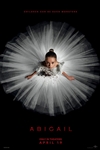
Abigail Released: April 19, 2024 Cast: Melissa Barrera, Dan Stevens 10.2M

Godzilla x Kong: The New Empire Released: March 29, 2024 Cast: Rebecca Hall, Brian Tyree Henry 9.5M

The Ministry of Ungentlemanly Warfare Released: April 19, 2024 Cast: Henry Cavill, Eiza Gonzalez 9M

Spy x Family Code: White Released: April 19, 2024 Cast: Takuya Eguchi, Saori Hayami 4.9M

Kung Fu Panda 4 Released: March 8, 2024 Cast: Jack Black, Viola Davis 4.6M
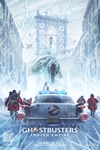
Ghostbusters: Frozen Empire Released: March 22, 2024 Cast: Paul Rudd, Carrie Coon 4.4M

Dune: Part Two Released: March 1, 2024 Cast: Timothée Chalamet, Rebecca Ferguson 2.9M
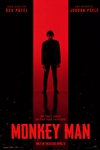
Monkey Man Released: April 5, 2024 Cast: Dev Patel, Sikandar Kher 2.2M
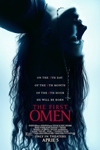
The First Omen Released: April 5, 2024 Cast: Nell Tiger Free, Bill Nighy 1.7M






